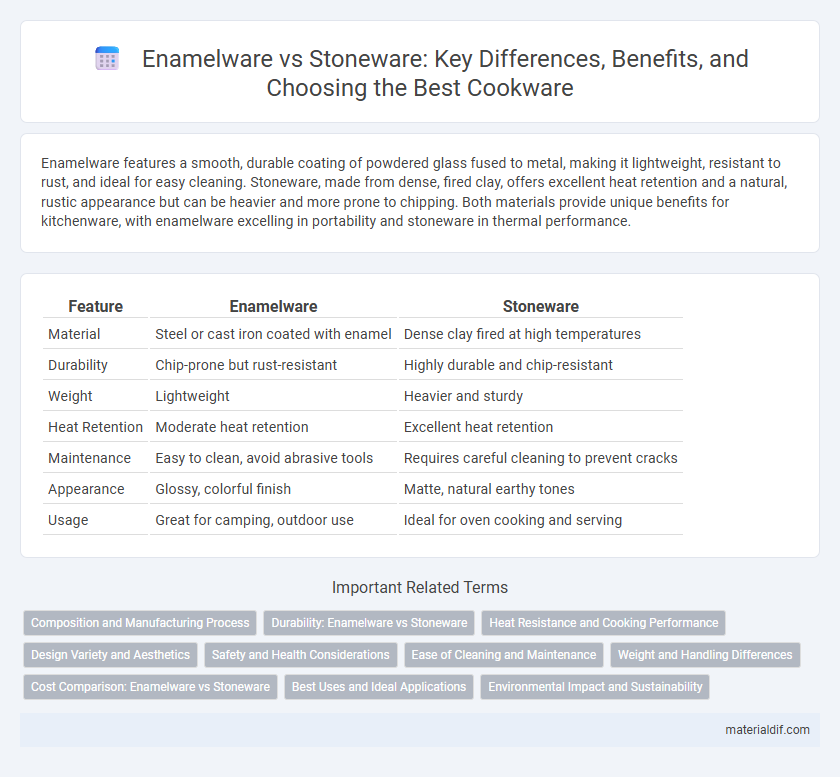Enamelware features a smooth, durable coating of powdered glass fused to metal, making it lightweight, resistant to rust, and ideal for easy cleaning. Stoneware, made from dense, fired clay, offers excellent heat retention and a natural, rustic appearance but can be heavier and more prone to chipping. Both materials provide unique benefits for kitchenware, with enamelware excelling in portability and stoneware in thermal performance.
Table of Comparison
| Feature | Enamelware | Stoneware |
|---|---|---|
| Material | Steel or cast iron coated with enamel | Dense clay fired at high temperatures |
| Durability | Chip-prone but rust-resistant | Highly durable and chip-resistant |
| Weight | Lightweight | Heavier and sturdy |
| Heat Retention | Moderate heat retention | Excellent heat retention |
| Maintenance | Easy to clean, avoid abrasive tools | Requires careful cleaning to prevent cracks |
| Appearance | Glossy, colorful finish | Matte, natural earthy tones |
| Usage | Great for camping, outdoor use | Ideal for oven cooking and serving |
Composition and Manufacturing Process
Enamelware is composed of a metal base, typically steel or cast iron, coated with a vitreous enamel layer made from powdered glass fused at high temperatures, providing a smooth, non-porous, and durable surface. Stoneware consists of dense clay fired at high temperatures between 1,100degC and 1,300degC, resulting in a vitrified, non-porous ceramic material with high strength and thermal shock resistance. The manufacturing process of enamelware involves metal shaping followed by enamel frit application and kiln firing, whereas stoneware undergoes clay molding, shaping, drying, and high-temperature kiln firing without additional coatings.
Durability: Enamelware vs Stoneware
Enamelware offers exceptional durability due to its vitreous enamel coating, which resists chipping, scratching, and rusting, making it ideal for outdoor use and rough handling. Stoneware, composed of dense, fired clay, provides strong resistance to thermal shock and heavy impacts but is more prone to chipping and cracking with drops or sudden temperature changes. Both materials exhibit high longevity, yet enamelware's non-porous surface enhances durability by preventing staining and bacterial absorption compared to stoneware's more porous structure.
Heat Resistance and Cooking Performance
Enamelware offers excellent heat resistance due to its glass-like coating on metal, allowing rapid and even heat distribution ideal for stovetop and oven use. Stoneware, composed of dense clay fired at high temperatures, retains heat longer and provides steady cooking performance but heats up more slowly than enamelware. While enamelware excels in quick temperature changes and easy cleanup, stoneware's heat retention enhances slow-cooked recipes and maintains consistent oven heat.
Design Variety and Aesthetics
Enamelware offers a wide range of vibrant colors and glossy finishes that enhance kitchen aesthetics with a retro or modern appeal. Stoneware features earthy tones and textured surfaces, providing a rustic, natural look that appeals to traditional and artisanal design preferences. The choice between enamelware and stoneware depends on desired color diversity and surface sheen, influencing overall visual impact and decorative style.
Safety and Health Considerations
Enamelware features a glassy, non-porous coating fused to metal, preventing food absorption and reducing bacterial growth for safer cooking compared to stoneware's porous ceramic surface, which can harbor bacteria and stains if cracked or chipped. Enamelware is free from harmful chemicals like lead and cadmium when properly manufactured, whereas some stoneware may leach these toxins if low-quality or improperly glazed. Enamel's resistance to rust and ease of cleaning enhances kitchen hygiene, while stoneware demands careful maintenance to avoid health risks related to its absorbent nature.
Ease of Cleaning and Maintenance
Enamelware features a smooth, glass-like coating that resists stains and food sticking, making it easier to clean compared to porous stoneware, which can absorb oils and odors. Maintenance for enamelware requires avoiding harsh abrasives to prevent chipping, while stoneware demands careful handling to avoid cracks and extensive soaking for thorough cleaning. The non-porous surface of enamelware allows for quicker drying and less bacterial growth than stoneware, enhancing overall hygiene and convenience in kitchen use.
Weight and Handling Differences
Enamelware is significantly lighter than stoneware, making it easier to handle and ideal for camping or everyday use where portability matters. Stoneware's dense, heavier composition provides sturdiness but can be cumbersome during cooking or serving. The lightweight nature of enamelware enhances its usability without compromising durability, while stoneware's weight offers heat retention and stability during use.
Cost Comparison: Enamelware vs Stoneware
Enamelware typically costs less than stoneware due to its simpler manufacturing process and lighter materials, making it a budget-friendly option for everyday use. Stoneware, made from dense clay fired at high temperatures, demands more resources and craftsmanship, reflecting in its higher price point. Choosing between enamelware and stoneware depends on balancing cost with durability and aesthetic preferences.
Best Uses and Ideal Applications
Enamelware excels in lightweight durability and resistance to rust, making it ideal for outdoor cooking, camping, and stovetop use. Stoneware, prized for its heat retention and even cooking, is perfect for baking and serving dishes directly from oven to table. Choosing enamelware suits quick heating and portability, while stoneware is best for slow-cooked, hearty meals and elegant presentation.
Environmental Impact and Sustainability
Enamelware is coated with a glassy layer fused to metal, making it highly durable, non-toxic, and fully recyclable, which reduces waste and environmental pollution. Stoneware, composed of natural clay fired at high temperatures, is biodegradable and often sourced from abundant raw materials, contributing to lower environmental degradation. Both materials offer sustainable options, but enamelware's recyclability and longevity often provide a smaller ecological footprint compared to the energy-intensive production and disposal challenges of stoneware.
Enamelware vs Stoneware Infographic

 materialdif.com
materialdif.com